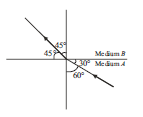Please refer to Chapter 1 Light Reflection and Refraction Case Study Questions with answers provided below. We have provided Case Study Questions for Class 10 Science for all chapters as per CBSE, NCERT and KVS examination guidelines. These case based questions are expected to come in your exams this year. Please practise these case study based Class 10 Science Questions and answers to get more marks in examinations.
Case Study Questions Chapter 1 Light Reflection and Refraction
Case/Passage – 1
A 5.0 cm tall object is placed perpendicular to the principal axis of a convex lens of focal length 20 cm. The distance of the object from the lens is 30 cm.
Question: What is the power of the used lens?
(a) + 5 D
(b) – 5 D
(c) + 0.5 D
(d) – 0.5 D
Answer
A
Question: What is the distance of image from the pole of lens?
(a) v = 60 cm
(b) v = – 60 cm
(c) v = 30 cm
(d) v = –30 cm
Answer
A
Case/Passage – 2
Light travels through a vacuum at a speed c = 3 × 108 m/s. It can also travel through many materials, such as air, water and glass. Atoms in the material absorb, reemit and scatter the light, however. Therefore, light travels through the material at a speed that is less than c, the actual speed depending on the nature of the material. To describe the extent to which the speed of light in a material medium differs from that in a vacuum, we use a parameter called the index of refraction (or refractive index).
Question: Figure shows a ray of light as it travels from medium A to

medium B. Retractive index of the medium B relative to
medium A is
(a) √3/2
(b)√2/3
(c)√1/2
(d) √2
Answer
A
Question:The path of a ray of light coming from air passing through a rectangular glass slab traced by four students shown as A, B, C and D in the figure. Which one of them is correct?

(a) A
(b) B
(c) C
(d) D
Answer
B
Question: A light ray enters from medium A to medium B as shown

in the figure. The refractive index of medium B relative to A will be
(a) greater than unity
(b) less than unity
(c) equal to unity
(d) zero
Answer
A
Question: You are given water, mustard oil, glycerine and kerosene.
In which of these media, a ray of light incident obliquely at same angle would bend the most?
(a) Kerosene
(b) Water
(c) Mustard oil
(d) Glycerine
Answer
D
Question: A ray of light is incident in medium 1 on a surface that separates medium 1 from medium 2. Let v1 and v2 represent the velocity of light in medium 1 and medium 2 respectively. Also let n12 and n21 represent the refractive index of medium 1 with respect to medium 2 and refractive index of medium 2 with respect to medium 1, respectively. If i and r denote the angle of incidence and angle of refraction, then-
(a) sin i/sin r = n21V1/V2
(b) sin i/sin r = n21V2/V1
(c) sin i/sin r = n12V1/V2
(d) sin i/sin r = n12 V2/V1
Answer
A
Case/Passage – 3
Inside a substance such as glass or water, light travels more slowly than it does in a vacuum. If c denotes the speed of light in a vacuum and v denotes its speed through some other substance, then v = c/n where n is a constant called the index of refraction.
To good approximation, a substance’s index of refraction does not depend on the wavelength of light. For instance, when red and blue light waves enter water, they both slow down by about the same amount. More precise measurements, however, reveal that n varies with wavelength. Table presents some indices of refraction of Custon glass, for different wavelengths of visible light. A nanometer (nm) is 10–9 meters. In a vacuum, light travels as c = 3.0 × 108 m/s

Question: Inside Custon glass
(a) Orange light travels faster than yellow light
(b) Yellow light travels faster than orange light
(c) Orange and Yellow light travels equally fast
(d) We cannot determine which color of light travels faster
Answer
A
Question: Which of the following phenomena happens because n varies with wavelength
(a) A lens focuses light
(b) A prism breaks sunlight into different colors
(c) Total internal reflections ensures that light travels down a fiber optic cable
(d) Light rays entering a pond change direction at the pond’s surface
Answer
B
Question: For blue-green of wavelength 520 nm, the index of refraction of Custon glass is probably closest to
(a) 1.49
(b) 1.50
(c) 1.51
(d) 1.52
Answer
C


